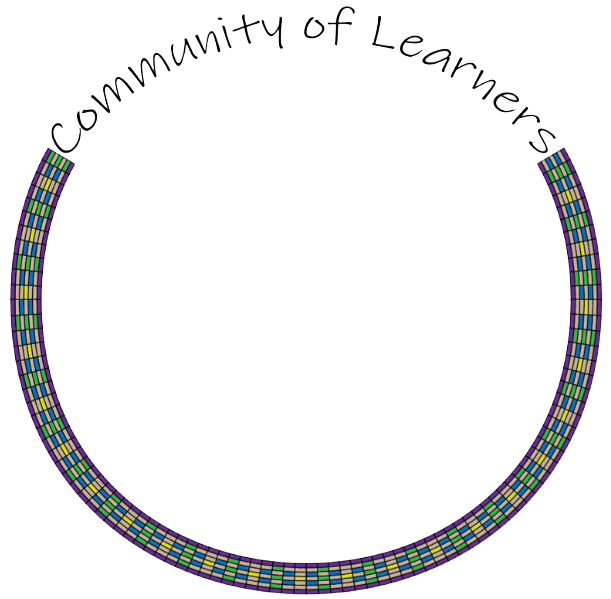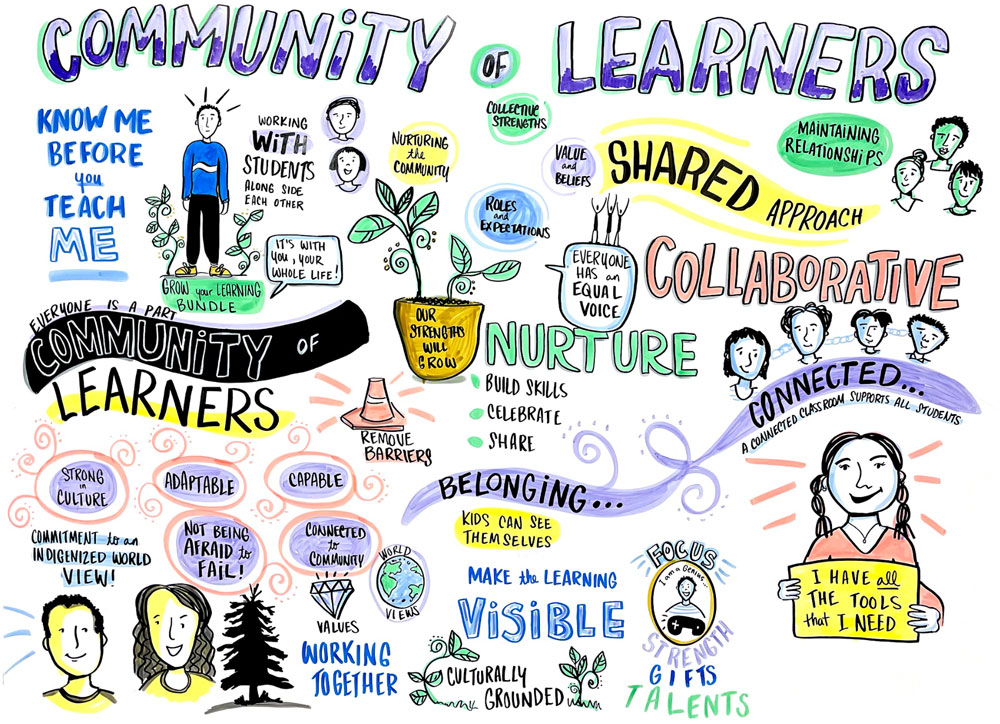The Power of Circles and Team Building
Circle protocols and Team Building are essential to building relationships and are embedded throughout all components of the Community of Learners. September is the time to create strong routines and protocols using circles and team building to help build strong communities in the classrooms.

Circles
Circles are powerful. Circles can be a support to lighten loads, can help build empathy, can set the tone for learning, and they can be a safe strong place to discuss and reflect on feelings, thoughts, and ideas. They can support learning about content, lesson objectives and themes. They can be organized by all members of the community.
- Are equitable, a place where everyone is seen
- Give each person a voice
- Represent the cyclical nature of beings and relationships
- Are a routine that helps build trust and safety
- Students are able to pass, but the expectation should be that everyone will participate eventually
Circles in the Classroom
Physical Setup:
- Arrange seats in a circle or sit in a common spot in a circle where everyone is included and can see each other
- Begin using a consistent object that you can pass around for each person to hold when they are speaking: “a talking object” to build norms and expectations.
Circle Protocols:
- Everyone in the circle listens to the person speaking
- The talking object is passed with respect
- We speak for ourselves and about ourselves
- Even if what we hear is hard, we use self regulation and mindfulness strategies (such as breathing exercises, fidget tools, self talk etc.) to stay focused and respectful
- Try hard to use the bathroom and get hydrated before you enter into the circle
- Try to be open and positive about what is said in circle
An inclusive approach to setting up and running circles in the classroom
Everyone starts together and students engage in the ways they are able. The goal is for each student to be able to do the Need/Must sections and then the path is differentiated from there.
Circles are important to building trust and enabling students to find their voice. The gradual build from interest circles, to check in circles, to content circles etc. establishes communication norms that help students feel safe to share. Circles are widely used in a variety of learning situations including conferences, courses, meetings and training, especially in Indigenous communities. If the structural organization of circles is difficult, consider placing seats in a circle to begin the year, building from there.
Need | Join the circle |
Must | Join the circle and listen to the speaker. |
Can | Sit in the circle, listen attentively, and speak when it’s your turn |
Could | Sit in the circle, actively listen, speak when it’s your turn with responses that show attention to what has been shared by others. |
Try | Sit in the circle, actively listen, speak when it’s your turn, share personal perspectives, new ideas, and build on the ideas of others. |
Team Building
Team building gives students the opportunity to collaborate and build communication skills in a fun, engaging way that strengthens the community bond and feeling of connection. It allows students to use their strengths and gifts in low risk situations to help increase confidence. Team building activities prepare students to try new things, be resilient when faced with challenges, and see the benefits of working together to complete a task. Students should be given the opportunity to work through challenges with safe/chosen partners at first and then with other groups to help create safety and trust learning with ALL students in the class. It is important to begin in a way that brings learners in with fun low risk challenges and then build in curricular skills, link challenges to lessons and units, and be mindful of the skills and competencies students demonstrate during these challenges.
- Brings laughter and joy into the classroom community
- Allows students to use their strengths and gifts to solve a problem
- Gives students a chance to practice conflict resolution in low risk situations
- Student input in team building activities allows them to voice their interest and increases engagement
- This is a fantastic way to include SA and PST support. SAs are creative and know a variety of ways to get students participating and learning from each other
- Team building activities hit many outcomes in ELA and Health
- Team building activities are a low risk way to promote oracy skills and many of the Key Competencies
Team Building in the Classroom
Team Building protocols:
- Everyone in the community has a role to play
- Communication has to be respectful and appropriate
- All members of the community should have a chance to experience success
- Grouping for activities needs to change regularly to ensure all members of the community can work together
- Competition needs to be respectful and not the end goal for activities that have multiple groups
- Vary who chooses team building activities. Scaffold as your community connections deepen to build in more student voice and choice
Team Building Protocols:
- Everyone in the community has a role to play
- Communication has to be respectful and appropriate
- All members of the community should have a chance to experience success
- Grouping for activities needs to change regularly to ensure all members of the community can work together
- Competition needs to be respectful and not the end goal for activities that have multiple groups
- Vary who chooses team building activities. Scaffold as your community connections deepen to build in more student voice and choice
Activity Resource Collections:
Activities:
- Helium Hoop – Grade k+
- Shark Attack – Grade 1+
- Shrinking Classroom – Grade 1+
- Puzzleland – Grade 1+
- Seeing Spots– Grade 1+
- Crossing the River – Grade 1+
- Classification – Grade 2+
- Leaning Tower of Feetza – Grade 2+
- Cup Stack – Grades 3+
- Blanket Switch – Grade 3+
- The Tallest Building – Grades 4+
- Hot Seat – Grade 4+
- Down the Line – Grade 5+
- Photo Finish – Grade 5+
- Over the Electric Fence – Grades 5+
- The Human Knot – Grades 5+
- Blind Artist – Grade 5+
- Rope Challenge – Grade 5+
- Height is Right – Grade 7+
- Dog, Rice, and Chicken – Grade 7+
- Murder Mystery Games – Grade 9+

